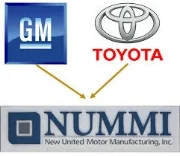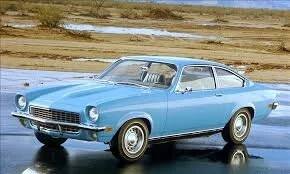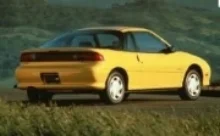If you can’t beat ‘em, join ‘em. That might as well have been the motto of Geo, a brand created by General Motors to sell rebadged Japanese cars. It was the least trumpeted of a progression of well-meaning but poorly executed attempts by General Motors to find a way…any way…to make money selling small cars. If you weren’t paying attention during its brief 8-year existence, you’ve probably never heard of Geo. Judging by the brand’s impact on the small car market; you weren’t alone.
The 1966 Corona: The first Japanese car designed with U.S. consumers in mind
In the early 1980s, after more than two decades of trying and failing to make a high quality small car at a competitive price, General Motors swallowed its pride to seek help. And it went to the master. Toyota was the top selling import car in America, and the most profitable car company in the world. Despite making mostly smaller cars, Toyota somehow managed to generate healthy profits year after year, no matter the economic conditions. This is because Toyota saw itself not so much as a car company, but a manufacturing company that made cars. Very good cars. It operated under a principal called kaizen, or continuous improvement. For Toyota, kaizen wasn’t just a catchy word printed on buttons and affixed to executive lapels, as was the practice in Detroit in those days. At Toyota it was a religion. Kaizen did not mean constantly adding more gadgets to their cars; it meant constantly improving the process by which their cars were designed, built and presented. Better cars, higher quality, more efficiency, reduced costs. If General Motors was serious about making a profitable small car it had to get religion from Toyota.
Honda assemby plant in marysville, ohio
While General Motors was looking to Toyota, Toyota was looking at Honda. What they saw was their much smaller rival gaining the upper hand in the most important car market in the world. Honda had recently become the first Japanese carmaker to open an automobile manufacturing plant in the U.S., and was now selling every U.S.-built Accord it could make.
Toyota was also looking at Washington, D.C. By 1982, the third year of a brutal recession, Japanese cars were accounting for over 25% of the U.S. market. In order to stem the tide, desperate American auto companies, together with a politically powerful United Auto Workers union, pressed Congress hard for protectionist legislation. Japanese car makers sought to head off official measures that might do them long-term harm. They offered instead to implement a temporary quota system called the Voluntary Export Restraint agreement (VER) that limited auto exports from Japan to 1.68 million vehicles. Everyone who stayed awake during the first day of Econ 101 knows that when supply is limited, prices rise. So even though their sales would be capped, Toyota’s profits would continue to soar.
This situation might have been quite tolerable for Toyota, except that now Honda, with its Marysville, Ohio plant, could potentially sell a quarter-million more cars each year that were not subject to the VER. It would take several more years before Toyota would complete its own U.S. plant in Georgetown, KY. They needed to do something fast in order to preserve their leadership position.
Japanese Chevys
www.riskculture.com.au
And so it was on February 14, 1983, Valentine's Day, that General Motors CEO, Roger Smith, and Toyota scion, Shiochio Toyoda, announced that the two companies would be hooking up to produce sub-compact cars at a recently-shuttered GM plant in Fremont, California. The joint venture would be called New United Motors Manufacturing, Inc, or NUMMI. Eight months later, Fremont was producing cars. Half were Toyota Corollas; the other half…were also Corollas, but with a bowtie on the grill and badges that proclaimed it a Chevy.
Chevrolet Nova by NUMMI
For GM, NUMMI provided a chance to learn Japanese manufacturing and management techniques. They wanted NUMMI to be a training ground for its managers after which they would spread what they learned though out the company. NUMMI was also meant to be a stopgap to hold them over until their much anticipated $5 billion Saturn small car project could be ready for launch in 1990.
For Toyota, the Freemont plant provided car sales that were not subject to the VER quotas. It was also a classroom for their executives who would be able to learn firsthand about intricacies of manufacturing in the U.S., as well as U.S. labor relations. They too had plans beyond NUMMI. Their own assembly plant was expected to be completed in Georgetown, KY in a few years.
Get to Know Geo
For the next three years GM sold NUMMI-built Chevrolet Novas…or at least they tried to. Around that time, an internal GM report was circulating showing that 28% of car buyers in 1987 had never been inside a domestic dealership...and never would. This was especially true for small car shoppers. Thrice burned - first by the ill-handling Corvair of the early sixties, then the self-destructing Vega of the early seventies, and just recently the recall-plagued Citation - they would be hard pressed to ever buy another Chevy.
Covair, Vega, Citation: 3 Strikes for GM
The Saturn project was supposed to address GM’s small car deficiency, but that was still several years off. In the meantime, the General threw an additional billion or so dollars at acquiring a piece of microcar maker, Suzuki, as well as to expand its stake in car and truck maker, Izuzu. Including NUMMI Toyotas, GM now had access to small cars from three different Japanese manufacturers.
General Motors...
...shares the love
Even though the new Saturn division was just 3 years away from producing cars, GM was in full scattershot mode. Its brain trust decided that yet another new brand would be needed to sell its imported and NUMMI-built small cars. Say hello to Geo.
Brain trust indeed. Despite their own data showing import buyers want nothing to do with Chevy dealers, the suits on the 14th floor decided to go ahead and sell imported Geos though their 4,900 Chevy dealers. Hell, someone was sure to see the sign out front, and accidentally stumble into a showroom.
The Geo brand was launched in 1989. It would eventually contain 4 models. The NUMMI-built Chevy Nova compact had become the Geo Prizm. A Canadian-made Suzuki Swift minicar became the Geo Metro, along with a Suzuki sourced truck-let that was badged the Geo Tracker. And finally, it was an Izuzu Impulse sport coupe that lay beneath that Geo Storm label.
Geo Metro
Geo tracker
geo storm
It seems like we should say more about these cars themselves, but why bother? They weren’t any better or worse than the originals. They weren’t any cheaper. What was the reason for these knockoffs? Other than to give Chevy dealers something…anything…to sell to import car buyers. You know, the ones who won’t ever set foot in a Chevy dealership. Over the band’s short life, each of those dealers would sell less than 40 Geos on average per year.
When Geo disappeared after 1996, no one much noticed. Too bad for that. Those billions of dollars General Motors threw at the small car market in the 1980s, with little to show for it, was yet another fine example why a decade later, that same General Motors would be bankrupt.
Copyright@2019 by Mal Pearson
Sources and Further Reading
Corporate Warriors: 6 Classic Cases in American Business by Douglas Ramsey (1987) Car Wars –pp179-211
Identity Crisis: A Century of Chevrolet The Automotive News Commemorative, October, 11, 2011 by Lindsay Chappell














